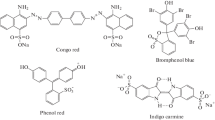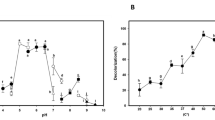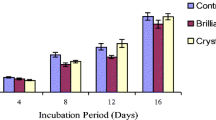Abstract
The decolorization of dye and textile effluent by Trametes hirsuta was studied in both induced and non-induced media. A removal of 70–100% of the color was achieved through adsorption and the action of laccases. Laccase activity was increased significantly with the addition of grapefruit peel (4000 U/mL) and effluent with grapefruit peel (16,000 U/mL) in comparison with the basal medium (50 U/mL). Analysis of the expression of laccase isoenzymes lac-B and lac-T revealed clear differences in the expression of these genes. The low levels of expression of lac-B in all media suggest a basal or constitutive gene expression, whereas lac-T was over-expressed in the media with effluent, and showed an up/down regulation depending on culture conditions and time. The results obtained suggest that the lac-T gene of T. hirsuta is involved in the decolorization of dyes.





Similar content being viewed by others
References
Ghaly A, Ananthashankar R, Alhattab M et al (2014) Chemical engineering and process technology production, characterization and treatment of textile effluents: a critical review. J Chem Eng Process Technol. https://doi.org/10.4172/2157-7048.1000182
Mani S, Chowdhary P, Bharagava RN (2019) Textile wastewater dyes: toxicity profile and treatment approaches. In: Emerging and eco-friendly approaches for waste management. Springer, Singapore, pp 219–244
Kumar PS, Saravanan A (2017) Sustainable wastewater treatments in textile sector. Sustainable fibres and textiles. Elsevier, Amsterdam, pp 323–346
Osma JF, Toca-Herrera JL, Rodríguez-Couto S (2011) Cost analysis in laccase production. J Environ Manag 92:2907–2912
Giardina P, Faraco V, Pezzella C et al (2010) Laccases: a never-ending story. Cell Mol Life Sci 67:369–385
Dwivedi UN, Singh P, Pandey VP, Kumar A (2011) Structure–function relationship among bacterial, fungal and plant laccases. J Mol Catal B 68:117–128
Garrido-Bazán V, Téllez-Téllez M, Herrera-Estrella A et al (2016) Effect of textile dyes on activity and differential regulation of laccase genes from Pleurotus ostreatus grown in submerged fermentation. AMB Express 6:93
Pezzella C, Lettera V, Piscitelli A et al (2013) Transcriptional analysis of Pleurotus ostreatus laccase genes. Appl Microbiol Biotechnol 97:705–717
Wang W, Liu F, Jiang Y et al (2015) The multigene family of fungal laccases and their expression in the white rot basidiomycete Flammulina velutipes. Gene 563:142–149
Viswanath B, Rajesh B, Janardhan A et al (2014) Fungal laccases and their applications in bioremediation. Enzyme Res 2014:163242
Senthivelan T, Kanagaraj J, Panda RC (2016) Recent trends in fungal laccase for various industrial applications: an eco-friendly approach—a review. Biotechnol Bioprocess Eng 21:19–38
Unuofin JO, Okoh AI, Nwodo UU (2019) Aptitude of oxidative enzymes for treatment of wastewater pollutants: a laccase perspective. Molecules 24:2064
Kunjadia PD, Sanghvi GV, Kunjadia AP, et al (2016) Role of ligninolytic enzymes of white rot fungi (Pleurotus spp.) grown with azo dyes. SpringerPlus 5:1487
Si J, Cui B-K, Dai Y-C (2013) Decolorization of chemically different dyes by white-rot fungi in submerged cultures. Ann Microbiol 63:1099–1108
Qin P, Wu Y, Adil B et al (2019) Optimization of laccase from Ganoderma lucidum decolorizing Remazol brilliant blue R and Glac1 as main laccase-contributing gene. Molecules 24:3914
Grassi E, Scodeller P, Filiel N et al (2011) Potential of Trametes trogii culture fluids and its purified laccase for the decolorization of different types of recalcitrant dyes without the addition of redox mediators. Int Biodeterior Biodegrad 65:635–643
Forootanfar H, Rezaei S, Zeinvand-Lorestani H et al (2016) Studies on the laccase-mediated decolorization, kinetic, and microtoxicity of some synthetic azo dyes. J Environ Health Sci Eng 14:7
Amaral PFF, Fernandes DLA, Tavares APM et al (2004) Decolorization of dyes from textile wastewater by Trametes versicolor. Environ Technol 25:1313–1320
Tapia-Tussell R, Pérez-Brito D, Rojas-Herrera R et al (2011) New laccase-producing fungi isolates with biotechnological potential in dye decolorization. Afr J Biotechnol 10(50):10134–10142
Tapia-Tussell R, Pérez-Brito D, Torres-Calzada C et al (2015) Laccase gene expression and vinasse biodegradation by Trametes hirsuta strain Bm-2. Molecules. https://doi.org/10.3390/molecules200815147
Ancona-Escalante W, Tapia-Tussell R, Pool-Yam L, et al (2018) Laccase-mediator system produced by Trametes hirsuta Bm-2 on lignocellulosic substrate improves dye decolorization. 3 Biotech. https://doi.org/10.1007/s13205-018-1323-y
Pereira-Patrón A, Solis-Pereira S, Lizama-Uc G, et al (2019) Molecular characterization of laccase genes from the basidiomycete Trametes hirsuta Bm-2 and analysis of the 5′ untranslated region (5′ UTR). 3 Biotech 9:160
Kirk TK, Croan S, Tien M et al (1986) Production of multiple ligninases by Phanerochaete chrysosporium: effect of selected growth conditions and use of a mutant strain. Enzyme Microb Technol 8:27–32
Rodríguez-Couto S, Rodríguez A, Paterson RRM et al (2006) High laccase activity in a 6 l airlift bioreactor by free cells of Trametes hirsuta. Lett Appl Microbiol 42:612–616
Zapata-Castillo P, Villalonga-Santana M, Tamayo-Cortés J et al (2012) Purification and characterization of laccase from Trametes hirsuta Bm-2 and its contribution to dye and effluent decolorization. Afr J Biotechnol 11:3603–3611
Sirianuntapiboon S, Sihanonth P, Somchai P et al (1995) An adsorption mechanism for melanoidin decolorization by Rhizoctonia sp. Biosci Biotechnol Biochem 59:1185–1189
Johannes C, Majcherczyk A (2000) Natural mediators in the oxidation of polycyclic aromatic hydrocarbons by laccase mediator systems. Appl Environ Microbiol 66:524–528
Carbone I, Kohn LM (1999) A method for designing primer sets for speciation studies in filamentous ascomycetes. Mycologia 91:553–556
Pfaffl MW (2001) A new mathematical model for relative quantification in real-time RT-PCR. Nucleic Acids Res 29:e45
Kaushik P, Malik A (2009) Fungal dye decolourization: recent advances and future potential. Environ Int 35:127–141
Kahraman S, Kuru F, Dogan D, Yesilada O (2012) Removal of indigo carmine from an aqueous solution by fungus Pleurotus ostreatus. Arch Environ Prot 38:51–57
Gonzalez JC, Medina SC, Rodriguez A et al (2013) Production of Trametes pubescens laccase under submerged and semi-solid culture conditions on agro-industrial wastes. PLoS ONE 8:e73721
Imran M, Asad MJ, Hadri SH, Mehmood S (2012) Production and industrial applications of laccase enzyme. J Cell Mol Biol 10(1):1–11
Larsson S, Cassland P, Jönsson LJ (2001) Development of a Saccharomyces cerevisiae strain with enhanced resistance to phenolic fermentation inhibitors in lignocellulose hydrolysates by heterologous expression of laccase. Appl Environ Microbiol 67:1163–1170
Bakkiyaraj S, Aravindan R, Arrivukkarasan S, Viruthagiri T (2013) Enhanced laccase production by Trametes hirusta using wheat bran under submerged fermentation. Int J ChemTech Res 5:1224–1238
Cambria MT, Ragusa S, Calabrese V, Cambria A (2011) Enhanced laccase production in white-rot fungus Rigidoporus lignosus by the addition of selected phenolic and aromatic compounds. Appl Biochem Biotechnol 163:415–422
Elisashvili V, Kachlishvili E, Khardziani T, Agathos SN (2010) Effect of aromatic compounds on the production of laccase and manganese peroxidase by white-rot basidiomycetes. J Ind Microbiol Biotechnol 37:1091–1096
de la Rubia T, Ruiz E, Pérez J, Martínez J (2002) Properties of a laccase produced by Phanerochaete flavido-alba induced by vanillin. Arch Microbiol 179:70
Goudopoulou A, Krimitzas A, Typas MA (2010) Differential gene expression of ligninolytic enzymes in Pleurotus ostreatus grown on olive oil mill wastewater. Appl Microbiol Biotechnol 88:541–551
González T, Terrón MC, Yagüe S et al (2008) Melanoidin-containing wastewaters induce selective laccase gene expression in the white-rot fungus Trametes sp. I-62. Res Microbiol 159:103–109
González T, Terrón MC, Yagüe S et al (2000) Pyrolysis/gas chromatography/mass spectrometry monitoring of fungal-biotreated distillery wastewater using Trametes sp. I-62 (CECT 20197). Rapid Commun Mass Spectrom 14:1417–1424
Li X, La G, Cheng Q et al (2014) Profile of natural redox mediators production of laccase-producing fungus Pleurotus ostreatus. Bull Environ Contam Toxicol 93:478–482
Elisashvili V, Kachlishvili E (2009) Physiological regulation of laccase and manganese peroxidase production by white-rot Basidiomycetes. J Biotechnol 144:37–42
Blánquez P, Guieysse B (2008) Continuous biodegradation of 17β-estradiol and 17α-ethynylestradiol by Trametes versicolor. J Hazard Mater 150:459–462
Khlifi R, Belbahri L, Woodward S et al (2010) Decolourization and detoxification of textile industry wastewater by the laccase-mediator system. J Hazard Mater 175:802–808
Lade HS, Waghmode TR, Kadam AA, Govindwar SP (2012) Enhanced biodegradation and detoxification of disperse azo dye Rubine GFL and textile industry effluent by defined fungal-bacterial consortium. Int Biodeterior Biodegrad 72:94–107
Asgher M, Yasmeen Q, Iqbal HMN (2014) Development of novel enzymatic bioremediation process for textile industry effluents through response surface methodology. Ecol Eng 63:1–11
Kamida HM, Durrant LR, Monteiro RTR, de Armas ED (2005) Biodegradação de efluente têxtil por Pleurotus sajor-caju. Quim Nova
Wesenberg D, Buchon F, Agathos SN (2002) Degradation of dye-containing textile effluent by the agaric white-rot fungus Clitocybula dusenii. Biotechnol Lett 24:989–993
Palmieri G, Cennamo G, Faraco V et al (2003) Atypical laccase isoenzymes from copper supplemented Pleurotus ostreatus cultures. Enzyme Microb Technol 33:220–230
Cuamatzi-Flores J, Esquivel-Naranjo E, Nava-Galicia S et al (2019) Differential regulation of Pleurotus ostreatus dye peroxidases gene expression in response to dyes and potential application of recombinant Pleos-DyP1 in decolorization. PLoS ONE 14:e0209711
Xiao YZ, Hong YZ, Li JF et al (2006) Cloning of novel laccase isozyme genes from Trametes sp. AH28-2 and analyses of their differential expression. Appl Microbiol Biotechnol 71:493–501
D’Souza TM, Boominathan K, Reddy CA (1996) Isolation of laccase gene-specific sequences from white rot and brown rot fungi by PCR. Appl Environ Microbiol 62:3739–3744
Zapata-Castillo P, Villalonga-Santana L, Islas-Flores I et al (2015) Synergistic action of laccases from Trametes hirsuta Bm2 improves decolourization of indigo carmine. Lett Appl Microbiol 61:252–258
Kozak M (1989) Circumstances and mechanisms of inhibition of translation by secondary structure in eukaryotic mRNAs. Mol Cell Biol 9:5134–5142
Acknowledgements
The names of funding organizations were Consejo Nacional de Ciencia y Tecnología (CONACYT)-FOMIX Award Number 108415 and Tecnológico Nacional de México Award Number 7409.19-P.
Author information
Authors and Affiliations
Contributions
All the authors contributed to this work. T-T and S-P conceived, designed and wrote the paper; P-P performed the experiments and analyzed the data; A-G, P-B, participated in the data analysis and writing of the paper; L-UC in the review and editing.
Corresponding author
Ethics declarations
Conflict of interest
The authors declare that they have no conflicts of interest.
Additional information
Publisher's Note
Springer Nature remains neutral with regard to jurisdictional claims in published maps and institutional affiliations.
Rights and permissions
About this article
Cite this article
Tapia-Tussell, R., Pereira‑Patrón, A., Alzate-Gaviria, L. et al. Decolorization of Textile Effluent by Trametes hirsuta Bm-2 and lac-T as Possible Main Laccase-Contributing Gene. Curr Microbiol 77, 3953–3961 (2020). https://doi.org/10.1007/s00284-020-02188-9
Received:
Accepted:
Published:
Issue Date:
DOI: https://doi.org/10.1007/s00284-020-02188-9




